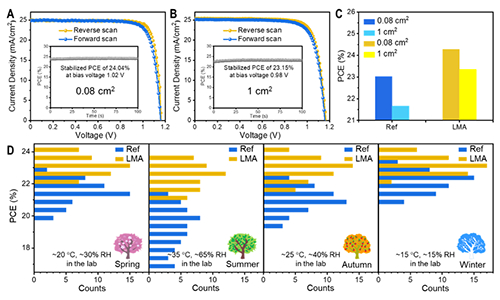Chinese scholars made progress on perovskite solar cells
With the support of the National Natural Science Foundation of China (Grant number: 51972004,21975028,22005035), the research groups of Prof. Huanping Zhou (School of Materials Science and Engineering, Peking University) and Prof Qi Chen (School of Materials Science and Engineering, Beijing Institute of Technology) made progress in the field of large area perovskite solar cells. The research work was published in Science on July 30, 2021, entitled “Liquid medium annealing for fabricating durable perovskite solar cells with improved reproducibility” (https://science.sciencemag.org/content/373/6554/561).
Recently, organic-inorganic hybrid perovskite based optoelectronic devices (such as solar cells, light-emitting diodes and photodetectors) have achieved great development due to the low raw-material cost and simple processing. The perovskite polycrystalline films are usually fabricated by solution processes and the film crystallization quality can greatly impact the corresponding device performance. However, the film growth is easily affected by envirenmental uncontrollable factors the local fluctuations of atmosphere such as humidity, organic vapor contents, etc., which are all hardly controlled. Moreover, the perovskite components exhibit high reaction activity under annealing conditions. Therefore, it is difficult to reproducibly fabricate large-area films with substantially uniform distribution of composition and phase state under traditional process, which limits their industrialization.
Here, the research group developed a simple annealing process, named “liquid medium annealing (LMA)”, to ensure the fabrication of high quality and uniform large-area perovskite films through creating a robust chemical environment and constant heating field to modulate crystal growth, which also effectively improved the process reproducibility. The liquid medium provided a unique “top-down” heat transfer on the perovskite film to shorten the annealing time and then accelerate crystal growth, which led to improved film homogeneity. Meanwhile, the liquid medium blocked the contact between perovskite and ambient conditions, especially inhibited the interference from water, oxygen and organic components, thus improved the crystal quality. Moreover, the LMA process allowed the device fabrication to be less dependent on the fabrication conditions.
The perovskite film prepared under LMA process exhibited more homogeneous optoelectronic performance and the efficiency gap between large area cell and small area cell was significantly reduced. The small-area device (with an aperture area of 0.08 cm2) delivered a stabilized power output of 24.04% and obtained a certified power conversion efficiency of 23.7%, while the large-area device (with an aperture area of 1 cm2) delivered a stabilized power output of 23.15% and yielded a certified power conversion efficiency of 22.3%, which is the highest certified PCE ever reported for 1-cm2 perovskite solar device. Therefore, this method is expected to be further extended to the fabrication of large-area solar cell modules. This method opens a new and effective avenue for all-weather fabrication of high quality and uniform perovskite films in a scalable and reproducible manner, which can be widely adopted in the fabrication of perovskite optoelectronic devices (such as solar cells, light-emitting diodes.) with different components (such as three-dimensional lead perovskite, tin-lead perovskite and two-dimensional perovskite.).

Figure 1. Diagram of the liquid medium annealing process and corresponding mechanism.

Figure 2. J–V curves of LMA devices with aperture area of 0.08 cm2 (A) and 1 cm2 (B). Inset: Stabilized power output at the maximum power point tracking. (C) PCE comparison of the best-performing 0.08-cm2 PSCs and 1-cm2 PSCs under the Ref and LMA processes, respectively. (D) PCE distribution of Ref- and LMA-fabricated PSCs under different seasons.
Contact Us

National Natural Science Foundation of China
Add: 83 Shuangqing Rd., Haidian District, Beijing, China
Postcode: 100085
Tel: 86-10-62327001
Fax: 86-10-62327004
E-mail: bic@nsfc.gov.cn
